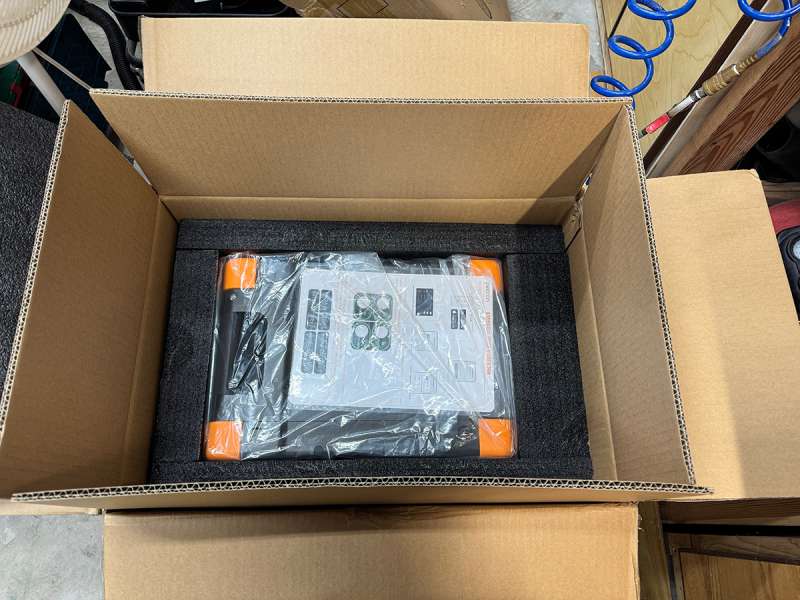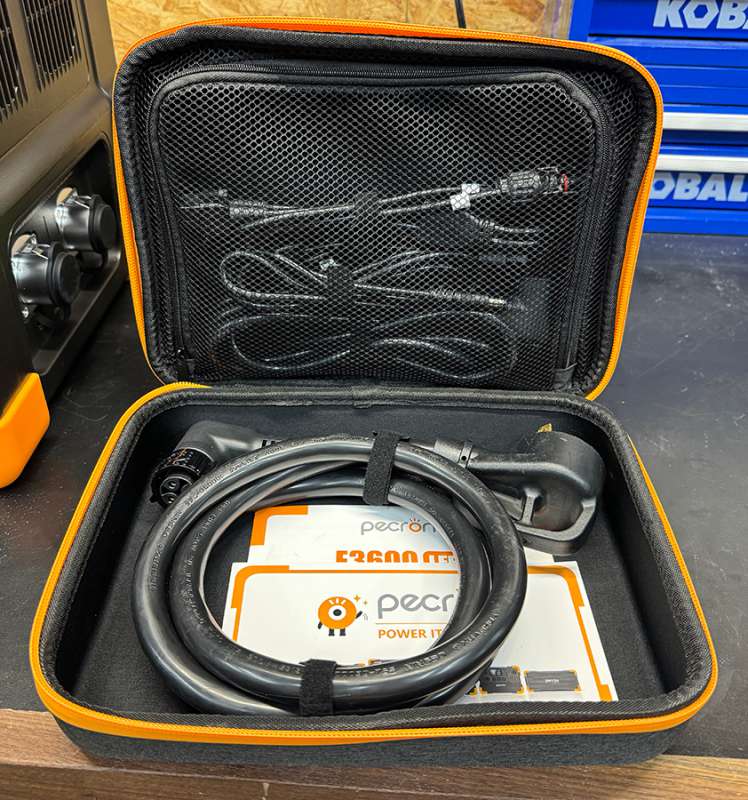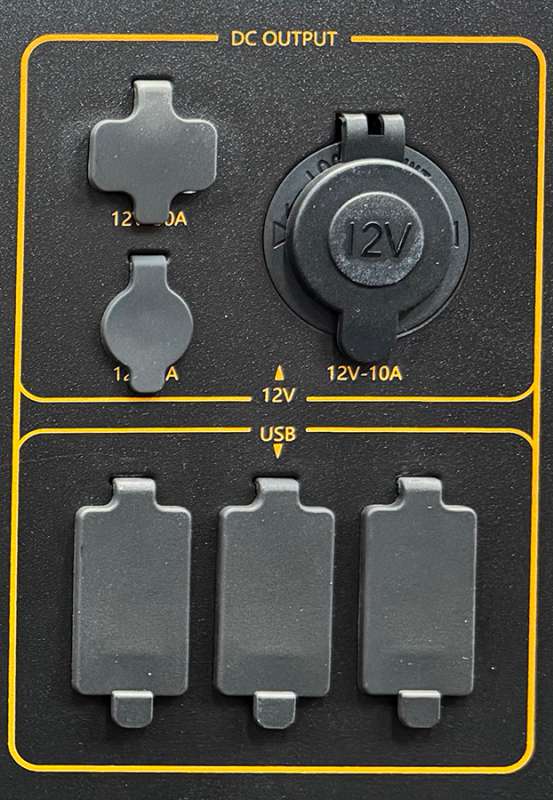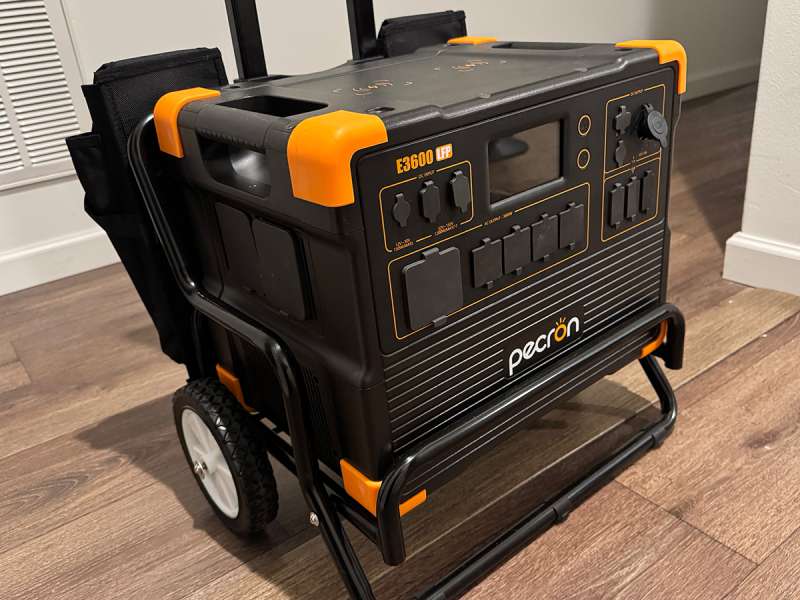REVIEW – I have lived in Florida for almost my entire life. One thing I’ve never gotten used to is the hurricane season and the power outages that come with it. Thankfully, we’ve never had a devastating storm wipe us out like many in our state. We’ve talked about getting a whole-home generator in every home we have lived in (which is 12 at last count). For one reason or another, we haven’t. This is why something like the PECRON E3600LFP Portable Power Station will be a much-needed addition to our hurricane prep kit. Let’s explore this latest offering from PECRON and see what sets it apart from similar products.
What is it?

The PECRON E3600LFP Portable Power Station is a 3072 Wh (watt-hours) “portable” power station that will provide up to 3600 watts of output. It has the latest LiFePO4 battery technology which will provide longer life on the battery cells inside. It has a whopping 16 output ports, with 5 for AC power and 11 for DC power. It can recharge either by AC via 100-120V at 3200W (max), and by DC 12V – 30V at 150W (max) or 32V – 150V at 2400W (max). If that isn’t enough, it can act as a UPS (uninterruptible power supply) while plugged in. This unit can act as the head unit to a multi-piece whole-home battery solution if used with expansion packs (purchased separately) from PECRON. The PECRON E3600LFP can meet most, if not all, of your power needs.
What’s included?

- PECRON E3600LFP Portable Power Station
- 15A AC charging cable
- 30A AC charging cable
- Single port XT60 to MC4 solar charging cable
- Parallel (dual) port XT60 to MC4 solar charging cable
- Car 12V charging cable
- Small screwdriver
- Accessory pouch
- User manual
This review also includes the optional T2 Trolley from PECRON for moving this hefty battery pack around.
Tech specs
Click to expand
- Rated power output: 3600W
- Surge power output: 7000W
- Battery capacity: 3072 Wh (expandable to 15,360Wh with 4 EP3000-48V expansion batteries)
- LiFePo4 Battery with 3,500+ Life Cycles to 80%
- 5 AC output ports: (4) standard BS-U20 20A outlets, (1) TT30-R 30A outlet
- 11 DC output ports: (4) USB-A (5V/9V/12V @18W max) , (1) USB-C (5V/9V/12V @ 18W max), (1) USB-C (5V/9V/12V/20V @ 100W max), (1) XT-60-F (12V @ 30A max), (1) Car adapter (12V @ 10A max), (1) DC-5525 port (12V @ 5A max), and (2) Qi wireless charging pads (15W max).
- AC input: 100V – 120V @ 30A, 3200W Max
- DC input: DC 12V – 30V @ 7A, 150W Max or 32V – 150V @ 20A, 2400W Max
- UPS function switchover within 8-20 milliseconds
- Charge time (AC) 0% – 100%: about 2 hours
- User-adjustable charging speed
- Wireless technology: Bluetooth and WiFi – unit can be monitored from anywhere if it is connected to WiFi.
- Charging Temperature: 0°C – 45°C / 32°F – 113°F
- Discharge Temperature: -20°C – 45°C / -4°F – 113°F
- Dimensions: L 17.5in (445mm) x W 12.1in (307mm) x H 13.8in (350mm)
- Weight: 79 lbs (36 kg)
Design and features
The PECRON E3600LFP Portable Power Station exceeded my expectations right out of the box. Its many ports and display are intuitively laid out on the front, top, and sides.

The PECRON E3600LFP is well-packaged for its long journey from China. It was packed inside a well-padded box, inside another shipping box. The delivery man was not happy with me and this nearly 100 lbs (45 kg) package. Getting the power station out of the padded inner box was quite a chore, but once freed, it was much easier to move around with the two handles on the top.

The PECRON E3600LFP comes with a handy pouch to hole the manual and 5 cables it came with.

The PECRON E3600LFP power station comes with several cables used to charge the battery pack. First is the one I used the most, the 15A AC Cable. It connects on the left side to the AC input port. Also included is a 30A AC charging cable. This allows for a higher amperage outlet to be used to charge the power station at a higher rate.
Also included are 2 different solar panel charging cables to connect from one to four solar panels. I did not get a chance to test the solar power charging feature, but from what I understand, using solar panels is a very slow way to charge a battery with a large capacity such as the PECRON E3600LFP. The user manual provides great instructions for connecting the solar panels to the DC charging ports.
Physical Lay Out

The front of the PECRON E3600LFP is very well laid out into 4 easy to understand sections: DC charging, AC output, DC output, and the display screen.

The DC charging section has two types of connectors for low-wattage )less than 30V) DC input, such as a car’s cigarette adapter or a low-wattage solar panel. There are also two XT60 type ports for higher wattage solar panels from 32V to 150V @ 20A, 2400W max. That is a lot of DC power to charge this thing.

The next section of the PECRON E3600LFP front panel is the AC output. It includes a single 30A outlet for higher output uses. Powering an RV would be a common use for such a high-amperage port.
This AC output section also includes four 15A common power outlets as you would find in any US home. The combined use of these four outlets is 3600W max, which would drain the PECRON E3600LFP in about an hour.

The DC output section includes many different options. Three different 12V ports with one each of XT60, Car adapter, and barrel type ports are included. Also in the DC output section are four USB-A ports, 2 USB-C ports, and 2 Qi Wireless pads on top of the PECRON E3600LFP. If you need something charged with DC power, it’s very likely the PECRON E3600LFP power station has you covered.

The display of the PECRON E3600LFP has all the information you need to monitor its power input during recharging, and its power output during use. The user manual does an excellent job of describing all the display elements, such as recharging wattages, time to finish recharging, output wattages and time to battery depletion. Battery pack temperature, remaining voltage, and remaining capacity percentage are also displayed. Several screens of the display show the system status including individual battery voltage and temps.
There is also a settings menu that allows various system-level settings to be adjusted. Once again the user manual is written very well and walked me through setting all this up.

The left side of the PECRON E3600LFP has two sections. The first is the overcharge reset switch. This is a safety device to protect the power station from suffering any damage due to charging spikes. There is also an RJ-45 connector for a SyncE interface and a grounding port for grounding the unit if needed.
Also on the left side is the input port for the 15A and 30A charging cables. Is it a very robust, screw-in type connector to ensure the charging cables will not wiggle loose.
The right side has two expansion ports for connecting up to four PECRON EP3000-48V Expansion battery packs to create a mega-power station.
PECRON App

PECRON provides a free app for iOS and Android mobile devices that allows the PECRON E3600LFP to be monitored and controlled remotely. The app provides mobile device access to most of the controls and settings from the device’s main display and sub-menus. I preferred using the device’s main display over the app, but it was handy using the app to monitor a long-running test I performed with my home refrigerator hooked up to the PECRON E3600LFP. I was able to monitor the PECRON E3600LFP’s battery level while I was away from home. See the results of that test below.
T2 Trolley Assembly and Use

The PECRON E3600LFP is very heavy and bulky. Earlier in this review, I described the power station as “portable”. Although the unit has handles, and you can move it around, it is not very easy to do so. At almost 80 pounds, PECRON recognized you will need a different way to move it from place to place. They offer a trolley as a separate purchase. I think the trolley is a requirement for the E3600LFP because of its size and weight.

Assembling the Trolley was easy enough. Just a few pieces of frame and two wheels screwed together. It comes with two handy bags that attach to the back side of the Trolley to hold all of the cables the E3600LFP comes with.
Once assembled, it holds the PECRON E3600LFP power station like a glove. It is much easier to roll around than carry. Getting it up and down steps was still difficult, but I think it was better than trying to carry it. It has a retractable handle similar to most roll-around suitcases.

During my testing, I was rolling the E3600LFP down the hall of my home, and one of the wheels had worked itself loose and came off. The trolley axle dug into my flooring and stopped me instantly. The issue is the screws included to attach the wheels are only about 3/4” (18 mm) long. I used a little automotive thread locker to lock the screws into the axle and hopefully, that does not happen again.
Performance
Out of the box, the PECRON E3600LFP was charged about 75%. So the initial charging took about 35 minutes. Once fully charged, I was able to set up the WiFi connection and jumped right into testing.

One of the advertised uses for the PECRON E3600LFP is taking it camping. Although I think this is a little ambitious given its size and weight, I tested it using a hot plate to cook some food. It handled that admirably. I did notice that the hot plate drew 854 watts, which would drain the power station in about 3.5 hours.

Since I live in Florida, I wanted to simulate the use of the PECRON E3600LFP in the aftermath of a hurricane with total power loss. I gathered a few things I thought we might use in that scenario: a fan, a lamp, a toaster, my wife’s tea kettle, our phones, the TV, and an internet modem and router.
Running all of that, except the toaster and kettle consumed very little power and would sustain us for at least 12 hours of continuous use. Once we cranked up the toaster and tea kettle, the power consumption skyrocketed and dropped the battery down to about 2 hours of use. The toaster and tea kettle would only be used occasionally, as would the lamp, TV, and internet modem and router. So in a power outage, we could have a few create comforts for about a day.

Another extended use test I wanted to do was running our full-sized home refrigerator solely on the fully charged PECRON E3600LFP until it shut off at 0% power remaining. The E3600LFP did very well and powered the refrigerator for about 25.5 hours at an average of about 90w before it died. That was with nothing else hooked up to the power station. If the refrigerator was hooked up on and off, and limited the opening of the doors, it might be able to stretch the power station use to maybe 36 hours. I was surprised how long the E3600LFP lasted, and how little power a modern refrigerator used. Recharging the E3600LFP after this test took around 2 hours. Just as advertised.
Internal Fans

The E3600LFP has fans built in to help cool the batteries when they are being recharged and discharged at higher rates. During the hurricane simulation, the fans did kick on occasionally, yet were very quiet and hardly noticeable. During the refrigerator test, the fans never ran.
Idle Power Loss
I recharged the PECRON E3600LFP to 100% and let it sit used for about a week. When I turned it back on, the battery capacity was at 99%. So, it lost about 1% of power while not being used. I did a little research and found that idle power loss is common in power stations that are left unplugged and that a 1% loss after one week was low compared to other power stations.
What I like about PECRON E3600LFP Portable Power Station
- LiFePo4 Battery chemistry should allow a long life
- Ample capacity for most non-extreme situations
- Charging time, empty to full, is extremely fast
- Very low idle power loss
- App control
What needs to be improved?
- The user manual didn’t explain how to use a few features
- The trolley should be an included accessory for the E3600LFP
- The trolley wheels need a better connection method
Final thoughts

The PECRON E3600LFP Portable Power Station is a very capable device and a welcomed addition to our ever-evolving hurricane/storm prep kit in our home. Its fast recharging is a major plus. Although it won’t power the entire house, it will ease the discomfort of not having power during our sweltering Florida summer storm seasons.
Price: $1,668 (regularly $2,399.00), T2 Trolley is $149.00.
Where to buy: Amazon and PECRON
Source: The sample of this product was provided for free by PECRON. PECRON did not have a final say on the review and did not preview the review before it was published.
